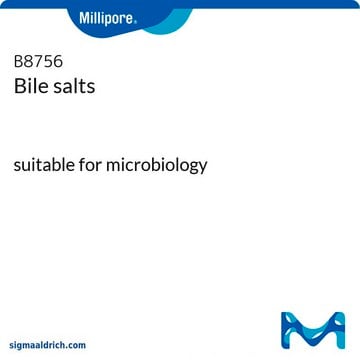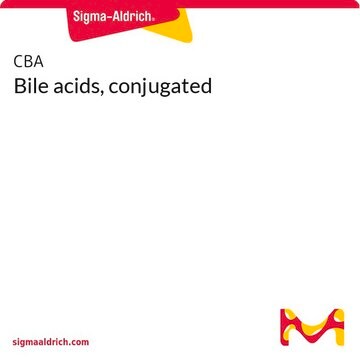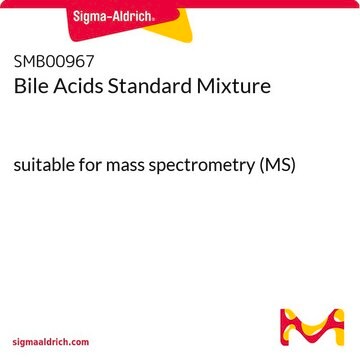The approximate amount of known components are listed below:
8.0 - 9.5% cholic acid
0.9 - 1.1% deoxycholic acid
32 - 36% conjugated cholic acid
11 - 13% conjugated deoxycholic acid
B8381
Bile from bovine and ovine
bile acid mixture
Synonyme(s) :
Bile acids
Sélectionner une taille de conditionnement
47,40 €
Sélectionner une taille de conditionnement
About This Item
47,40 €
Produits recommandés
Source biologique
bovine
ovine
Forme
powder
Technique(s)
microbiological culture: suitable
Application
Actions biochimiques/physiologiques
Composants
Mentions de danger
Conseils de prudence
Classification des risques
Aquatic Chronic 3
Code de la classe de stockage
11 - Combustible Solids
Classe de danger pour l'eau (WGK)
WGK 2
Point d'éclair (°F)
Not applicable
Point d'éclair (°C)
Not applicable
Équipement de protection individuelle
Eyeshields, Gloves, type N95 (US)
Faites votre choix parmi les versions les plus récentes :
Certificats d'analyse (COA)
Vous ne trouvez pas la bonne version ?
Si vous avez besoin d'une version particulière, vous pouvez rechercher un certificat spécifique par le numéro de lot.
Déjà en possession de ce produit ?
Retrouvez la documentation relative aux produits que vous avez récemment achetés dans la Bibliothèque de documents.
Les clients ont également consulté
Articles
Culture media provides a habitat with suitable nutrients, energy sources, and certain environmental conditions for the growth of microorganisms. The components of the culture media range from simple sugars to peptones, salts, antibiotics, and complex indicators.
-
Could you disclose the composition of this product (the bile acids themselves)? And its percentages.
1 réponse-
Utile ?
-
Filtres actifs
Notre équipe de scientifiques dispose d'une expérience dans tous les secteurs de la recherche, notamment en sciences de la vie, science des matériaux, synthèse chimique, chromatographie, analyse et dans de nombreux autres domaines..
Contacter notre Service technique















